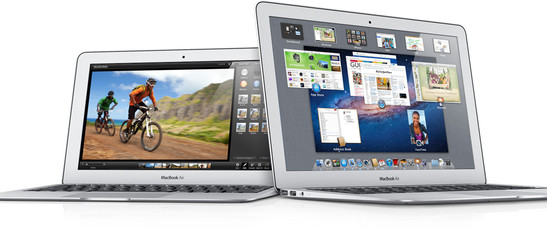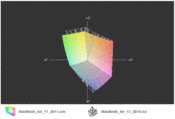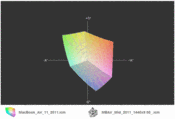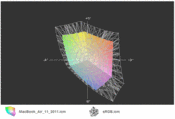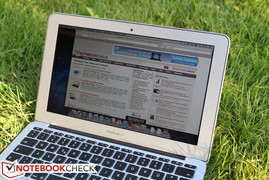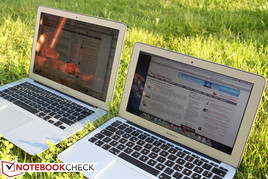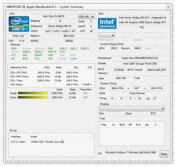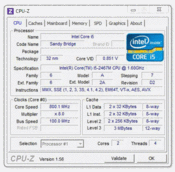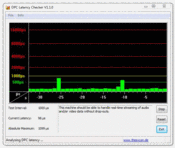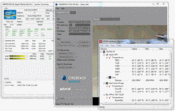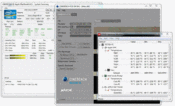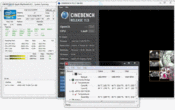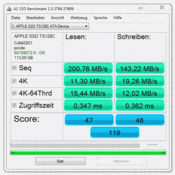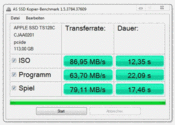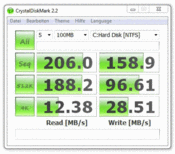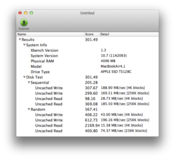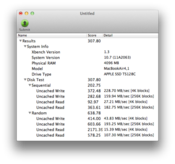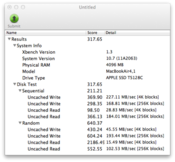Review Apple MacBook Air 11 Mid 2011 (1.6 GHz, 128 GB SSD) Subnotebook
Apple has stuck to this policy for years: set new trends, but don’t jump on any passing bandwagons. So for example the netbook hype of the last few years left practically no trace on the Apple product portfolio. Their answer was the iPad, producing results with which we are all familiar.
The MacBook Air dates back as far as 2008 in its first generation; given that the topic of ‘ultrabooks’, i.e. particularly slim notebooks priced at under 1000 dollars, is currently being discussed by many manufacturers, this will conjure up another knowing smile in the faces of hardware-savvy users. By the way, the Air 11’s official starting price is 999 dollars; what an amazing coincidence!
Case
For this 11-inch notebook, as with its big brother the MacBook Air 13, Apple has used the same chassis as it did for the Air 2010. And almost a year later, the aluminium unibody case is still one of the finest materials that today’s demanding user could call his own. The look, feel, build quality - there just aren’t any real points to criticise here. On the contrary, the longer you play around with the laptop, the higher your satisfaction levels will get in this regard. Details about the case can also be found in our test of the previous machine from 2010 which is identically constructed.
The keyboard still has LED backlighting, whose brightness can be set to many different levels much like the screen brightness. Compared to the 13-inch Air, you will see almost the same layout and key size. Only the row of F keys and the additional functions placed there (display brightness, volume, etc...) have been made thinner.
Connectivity
As with the 13-inch Air, Apple has added a Thunderbolt port to the Air 11. The other ports remain unchanged from the previous model, i.e. you have to make do with two USB 2.0 ports and a headphone port. Compared to the current 13-inch Air, you also have to do without an SD card reader.
On the topic of Thunderbolt it should be noted that there is not a lot of advantage to having this port at present. Only Apple itself offers a compatible 27-inch monitor (including additional ports), costing around 900 Euros. The Thunderbolt port can also be used as a mini-DisplayPort. So with the help of the appropriate cable or adaptor, conventional external monitors can also be connected to the Air. Further information about the Thunderbolt port can be found in our review of the MacBook Air 13.
Communication
WLAN which follows the 802.11 a/b/g standard is part of the standard hardware for this series, as well as Bluetooth 4.0. There is no RJ45 network port to be found; it was probably just too large for the Air. Apple does offer an appropriate and slow USB adaptor for this, for a price of course (around 30 Euros), or you can use the aforementioned Thunderbolt monitor with its LAN port.
Warranty
The manufacturer’s warranty for the Apple MacBook 11 is 12 months. You can also purchase warranty extensions of 12 or 24 months including telephone support.
Display
Although the core details of the display haven’t changed - 11.6-inch screen, 1366 x 768 resolution, glossy surface - it is still a new panel that has been built into this model. In our review model the panel has the identifier LP116WH4-TJA3 and is made by LG Philips. In some internet forums there are messages about a second display version (LTH116AT01A04) which could be made by Samsung.
Our LG display gave a maximum brightness of 355 cd/m² when tested with the Gossen Mavo meter. The average brightness is still extremely bright at 318 cd/m², making it one of the best for its class of machine. The black value of only 0.56 cd/m² is also excellent, along with the outstanding contrast ratio of 634:1.
Compared to the 2010 predecessor, which was fitted with an LTH116AT01A01 display, we can observe an improvement in terms of brightness (max. 340 cd/m², average 296 cd/m²).
Anandtech reviewed the MacBook Air 11 with the Samsung display (LTH116AT01A04) in their machine. The panel shows a slightly worse black value but a higher maximum brightness, at 0.61 and 386 cd/m² respectively. No rule has been observed yet which would determine which of the two possible display types is used in which configuration.
| |||||||||||||||||||||||||
Brightness Distribution: 76 %
Center on Battery: 355 cd/m²
Contrast: 634:1 (Black: 0.56 cd/m²)
40.1% AdobeRGB 1998 (Argyll 3D)
58.4% sRGB (Argyll 3D)
38.81% Display P3 (Argyll 3D)
A look at the colour space that can be represented does not produce any surprises. sRGB cannot be fully covered; the predecessor machine from 2010 was in roughly the same league, while the display from the MacBook Air 13 2011 (LP133WP1-TJA3) covers virtually the same area as this 11-inch display from the same manufacturer.
The stability of the viewing angles is wholly comparable with the 13-inch model that we tested, putting it slightly above average amongst recent notebooks. In the horizontal direction, even quite wide viewing angles are possible without causing great problems; in the vertical direction, the more you deviate from the ideal straight-on viewing angle, the more the picture washes out or is hit by the familiar inversion effect.
Performance
A new Sandy Bridge CPU gets its chance in this 11-inch MacBook Air, just like in the 13-inch version. The starting level is a i5-2467M CPU with a base speed of 1.6 GHz. The chip is somewhat slower than the i5-2557M CPU (1.7 GHz) which is the starting level for the 13-inch model. Just like with the larger model, there is an option to upgrade to the i7-2677M with 1.8 GHz.
Looking after your graphics needs is the Intel HD Graphics 3000 unit intregrated into the CPU. But here too, Apple differentiates between a version with 256 MB and one with 384 MB of shared memory. This is in direct relation to the amount of RAM in each model. Therefore in the 2 GB starting version (firmly soldered down, not upgradable!), the dynamic memory which is made available to the GPU is limited to 256 MB, while with 4 GB of RAM installed, the HD Graphics 3000 gets a larger portion assigned to it. But this does not change anything about the graphics unit itself. A large graphics memory is generally necessary or advantageous for games or a multi-monitor set-up.
CPU Performance
To judge the performance of the new Intel i5-2467M CPU we turn once again to our standardized CPU benchmark tools using Windows via Boot Camp. In the SuperPi 32 M test (calculating to exactly 32 million decimal places) the MacBook Air with the i5-2467M CPU needed exactly 903 seconds. To compare: Intel’s Arrandale 460M/ 520M processors rank at about the same level, while the new Intel i3-2310M Sandy Bridge CPU even needs a little longer (940-980) to complete the task. However, Apple’s MacBook Air 13 with the somewhat more powerful i5-2557M does calculate it much faster at 763 seconds, putting it in the same league as the Intel i5-2410M CPU. Looking back at the Air 11 from 2010 with its SU9400 CPU provides a powerful demonstration of the improvement in performance: 1936 seconds, which means that the calculating speed has more than doubled.
Whereas SuperPi only uses a single core, the WPrime benchmarking tool utilizes all the threads of the CPU. With 869.7 seconds in the 1024 M test, our chip remains just behind the latest i3-2310M processors. The current Air 13 is also ahead here, with 764.6 seconds (i5-2557M). The SL9400 CPU from the Air 13 2010 is again beaten by almost 50%.
In the Cinebench R10 (64 Bit) single CPU test the Air scores 3610 points with the 2467M processor, allowing it to stay just ahead of the Intel 2310M processors. The Air 13 with 2557M CPU achieves 4201 points in comparison, putting it almost at the level of the mid-range 2410M CPUs. In the same test, though in 32-Bit mode, the new Air once again beats its predecessor from 2010 by around double.
The results of the multi-thread rendering test by Cinebench (64 Bit) are much the same. With 7188 points the Apple Air 11 2011 comes only just behind other notebooks with the Intel Core i3-2310M CPU. But the Air 13 with its 2557M CPU makes up some lost ground in this test, scoring 8266 points; this is clearly a better result that the Air 11, but it also remains just as clearly behind other machines with the 2410M CPU. For the comparison to the Air 11 predecessor, we again had to make do with the 32-Bit mode because of a lack of comparable data. With 5946 points to 2852 points the new Air can once again beat the previous model from 2010 with the SU9400 CPU by more than 100%.
Finally we also ran the most recent Cinebench R11.5 CPU test. With 1.9 points, the 2467M CPU ranks at about the same level as the i3-330M Arrandale CPU, lagging just behind the modern 2310M chip. The Air from 2010 with the SU9400 processor achieves 0.9 points, again putting it, surprise surprise, at roughly only half the performance level of the new entry-level 2467M CPU.
| Cinebench R10 | |
| Rendering Single 32Bit (sort by value) | |
| Apple Macbook Air 11 inch 2011-07 MC969D/A | |
| Apple Macbook Air 13 inch 2011-07 | |
| Apple MacBook Air 11 inch 2010-10 | |
| Samsung 900X3A | |
| Rendering Multiple CPUs 32Bit (sort by value) | |
| Apple Macbook Air 11 inch 2011-07 MC969D/A | |
| Apple Macbook Air 13 inch 2011-07 | |
| Apple MacBook Air 11 inch 2010-10 | |
| Samsung 900X3A | |
| Cinebench R11.5 - CPU Multi 64Bit (sort by value) | |
| Apple Macbook Air 11 inch 2011-07 MC969D/A | |
| Apple Macbook Air 13 inch 2011-07 | |
| Apple MacBook Air 11 inch 2010-10 | |
| Samsung 900X3A | |
Geekbench - CPU Performance under Mac OS X
The small, ultra-thin notebook by Apple can also demonstrate its processing power when running Mac OS X. Particularly when compared to the old Core 2 Duo processors, the Core i5 is substantially faster and can even get ahead of the 2.4 GHz Core 2 Duo P8600 processor in the MacBook Pro 13 from 2010.
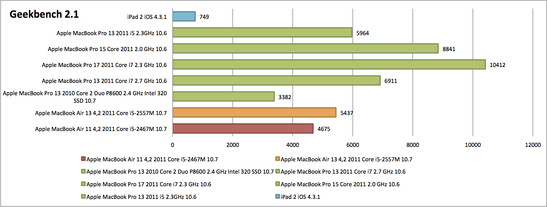
Throttling
We want to take another close look at the subject of throttling, because there have been some complaints about this in the past with other notebooks from Apple. Here, again, we used Boot Camp Windows as our testing platform because of the analysis tools it offers, as well as MacOS.
The Intel i5-2467M CPU used in this notebook has, like its fully-grown colleagues in the Sandy Bridge CPU portfolio, a certain bandwidth of speed, in this case from 1.6 to 2.3 GHz, depending on the number of threads/ cores being used at the time. How well this dynamic Turbo range can be exploited depends more than anything else on the cooling power of the notebook in question.
While in idle both cores still regularly get as fast as 2299 MHz (high-performance profile), the speed of both cores decreases to 1999 MHz under stress, that is, in the SuperPi as well as the Cinebench R10 single CPU test. Occasionally and only for a short time, a speeding up of a core to its maximum of 2.3 GHz could be observed. In the multi-thread Cinebench R10 test as well as in the Cine R11.5 CPU test, both cores remained stable at 1999 MHz according to our observations, even when the tests were carried out in a continuous loop.
It took the maximum stress scenario of Prime95 and Furmark for us to beat the clock speeds into submission. Shortly after the start of our stress test we observed a speed of 1199 MHz in both cores. After about an hour under the pressure of the stress test we finally observed a repeating, short-lived decrease in CPU speed to 799 MHz. Interestingly, the CPU temperature which we observed using HWMonitor always remained in the uncritical zone at about 80°C. The mains adaptor, however, is touching the limits of its energy-supplying capacity (45 W) with peak values of up to 44.9 W during the test. This could be a possible explanation for the repeated throttling that we saw.
We also took a detailed look at the pattern of behaviour in the benchmarks, whereby the latest MacBook Air for example has shown an interesting tendency to produce better results over time or with greater fan speed.
We start with the Cine R10 single CPU test. In the test loop we achieved scores of 3517, 3562, 3591, 3565, and 3610 points. The fan was continually increasing its speed from the end of the first test onwards (starting at about 80°C). The maximum CPU temperature we observed was only around 80°C (second run-through), while after that the temperature fluctuated around the 70°C mark. There are no signs of throttling here, in fact overall there was a slight improvement in the benchmark scores.
We tried the same pattern of tests based this time on the Cine R10 Multi CPU benchmark. We observed the following series of results: 7024, 7141, 7126, 7117, and 7188; the fan reached a speed of 5000 rpm in the third run-through and what is more, the CPU temperature stayed constant at just under 90°C following this.
In the more recent Cinebench R11.5 CPU test we saw an almost identical picture, with scores of 1.31, 1.91. 1.92, and 1.92 points. In the first run-through we observed CPU temperatures of up to 97°C. After that, the fan increased its speed, reaching its maximum of 6500 rpm, with which it can keep the CPU temperature stable at 80-84°C.
We then also carried out the Cinebench series of tests for MacOS X, although during this we were only able to evaluate the CPU temperature and the fan speed using the SMC FanControl tool. In the single CPU part of the Cine R10 test we observed the following series of results: 3142, 3194, 3150, 3159, and 3162.
In the first run-through, the fan starts to increase its speed from about 80°C onwards. This prevents an increase in temperature to more than 80°C, according to SMCFanControl. In addition, the fan speed never exceeded 3500 rpm during our observations.
In the multi-CPU test of Cinebench R10, we recorded the following series of results: 6452, 6522, 6511, 6493, 6510, 6490, and 6520.
During the first run-through the fan started to increase its speed at around the 90°C point. The fan speed increased during the subsequent run-throughs, and the CPU temperature was kept constant at quite some way under 90°C.
With MacOS as with Windows, higher temperatures were reached more quickly in the Cinebench R11.5 CPU test than in the Cinebench R10 multi-CPU test. The fan starts up relatively quickly and already reaches its maximum of 6500 rpm in the first run-through, keeping the CPU temperature below 80°C. This is substantially less than in the same test when running Windows, for example. The results: 1.92, 1.93, 1.93, and 1.94 points.
Conclusion:
While running Windows, the benchmarks appear to show a small improvement in the result every time you run them; but this effect vanishes almost completely when using MacOS, allowing for a certain amount of fluctuation. Critical temperatures are apparently reached less quickly with the i5-2467M than with the more powerful 2557M in the MacBook Air 13 that we have also reviewed. However, with the i7-2677M CPU which is available as an alternative option, a similar throttling effect could possibly emerge in the smaller Air 11.
Overall the fan control system seems to be fundamentally more effective under MacOS, once again, keeping the CPU in lower temperature regions during comparable levels of use.
Application Performance in Windows
The new 13-inch Air already put in an outstanding performance in our benchmark tests. In large part this was down to its solid state drive, which not only causes benchmark scores to rocket but also has a clearly noticeable positive influence during everyday use. For example the MacOS boot-up lasts only around 10 seconds. Boot Camp Windows, on the other hand, allows itself around 40 seconds following the selection menu, but what Apple Air user would be interested in that anyway...
Even so, the smaller Air 11 2011 managed a very good 9414 points in the PCMark Vantage benchmark test, placing it only around 10% behind its 13-inch brother (10,342 points). The 256 GB SSD in the Air 13 we tested was able to score much more highly in the HDD subscore, with 27,000 to 18,600, but also in the other subsections the Air 13 was quite some way ahead for the most part, with the interesting exception of the gaming scores.
The MacBook Air from 2010 scored 4095 points in the same test, i.e. in this area too it was behind by more than halfway.
In the latest PCMark 7 system benchmark, the Air 11 makes it into our Top Ten, like the latest Air 13 before it. With 3289 points, it is only 8% behind the Air 13 with the more powerful i5-2557M CPU and 256 GB SSD. We notice that the Fujitsu Celsius H710 for example (2820QM, Quadro 1000M, SSD), a powerful workstation laptop, also scored ‘only’ 3695 points here, slightly more than the Air 11. Meanwhile the list is topped by one of the most powerful mobile computers currently available, the Alienware M18x with two GTX 580M graphics cards and an overclocked 2920XM Extreme CPU (4 GHz), which scored 4636 points.
| PCMark Vantage Result | 9414 points | |
| PCMark 7 Score | 3289 points | |
Help | ||
XBench 1.3 – System performance in Mac OS X
The system benchmark Xbench 1.3, which is widely used but a little outdated, also gave the small MacBook Air 11 a very good score for overall performance. It did however remain behind the larger 13" model in all tests. The 2010 Air models were significantly beaten for the most part. Only in the graphics tests was the old GeForce 320M still able to show its strengths. Even the 13-inch MacBook Pro had to admit defeat in the processor and memory tests. The Intel SSD 320 in our 13-inch MBP is on about the same level as the SSD in the 11-inch MB Air, according to the Xbench test.
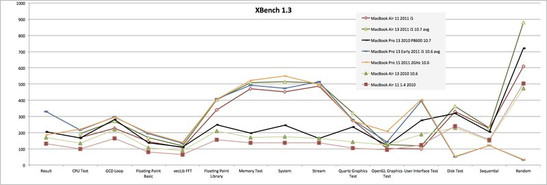
| PCMark 7 - Score (sort by value) | |
| Apple Macbook Air 11 inch 2011-07 MC969D/A | |
| Apple Macbook Air 13 inch 2011-07 | |
| Alienware M18x (GTX 580M SLI, 2920XM) | |
3D Performance
With the PCMark Vantage having placed the Air 11 ahead of its 13-inch big brother in the gaming section, despite their identical graphics, we ran the classic 3D benchmark 3Dmark 2006. And in fact the midget scored 3817 points (1280 x 1024) which is higher (though only slightly) than its larger colleague with 3808 points. Interestingly, the predecessor machine from 2010 only scored a marginally higher 3824 points, despite its Geforce 320M graphics. Overall the Air 11 takes a mid-table position compared to other current notebooks with Intel HD Graphics 3000 graphics (around 3000 – 5000 points).
In the gaming test, we examined the effects of the switch from the Geforce 320M to the integrated Intel HD Graphics 3000. At high details settings the Intel and Nvidia graphics units are practically on a level, with a slight advantage for the Geforce unit when it comes to the FIFA game; but at lower resolutions and detail settings the new MacBook Air can actually pull ahead thanks to its fundamentally more powerful CPU.
For an overview of which other modern games can be played on the Intel HD Graphics 3000, see our table ‘Computer games on laptop graphics cards’.
| low | med. | high | ultra | |
|---|---|---|---|---|
| Colin McRae: DIRT 2 (2009) | 35.4 | 21.1 | 12.8 | |
| Resident Evil 5 (2009) | 50.7 | 20.2 | ||
| Fifa 11 (2010) | 132.8 | 65.7 | 41.4 |
| 3DMark 06 Standard Score | 3817 points | |
| 3DMark Vantage P Result | 1633 points | |
Help | ||
SSD Performance
In terms of integrated mass storage, Apple has opted entirely for fast SSD technology for the smaller Air 11 as well. For the 11-inch model, unlike the 13-inch model, you have the choice between 64 GB or 128 GB of capacity in total. Here too, Apple has used models from different manufacturers, which could vary in their performance data. Our review model was fitted with a 128 GB SSD, made by Toshiba and with the model identifier TS128C. Apparently some Samsung units (SM128C) have also been used in the latest MacBook Air. These are a little faster than their Toshiba counterparts, according to various reports.
Our TS128C drive displayed writing speeds of around 228/169 MB/s in the sequential 4 K/ 256 K XBench disk benchmark. In the reading test, it dropped to 28 MB/s on the 4 K blocks, but remained at around 184 MB/s on the 256 K blocks. XBench shows the usual outliers in its tests here.
In the ASSSD benchmark the drive showed a rate of 200.76 MB/s in the sequential read test and 143.22 MB/s in the write test. In the 4 K test, both rates deteriorated markedly: 15.44 MB/s for reading, 12.02 MB/s for writing. The Samsung 256 GB SSD in the Air 13 showed similar behaviour, although with better rates in the writing test (205.39 MB/s and 19.08 MB/s). Intel's 310 series SSD produced similar rates in the ASSSD reading test when we reviewed it; however, it was a long way behind in the sequential writing test with 84 MB/s, whilst doing better than the Air 11 Toshiba unit in the 4 K test with 37 MB/s. OCZ's Vertex 2 is placed in a similar position, but with substantially better 4 K write results (77.7 MB/s). Brand-new solid state drives like the Intel Elmcrest for example or the OCZ Vertex 3 can do a lot better than this depending on the test.
Emissions
System noise
Even though the Apple MacBook Air 11 is a little smaller and has a slightly less powerful CPU (in this configuration) than the 13-inch model we tested, it still matches its big brother for low system noise. Whether on MacOS or Windows, we generally had an utterly silent machine in front of us. Even during short periods of stress, for instance during the Cinebench R10 benchmark, the fan stays on its lowest level of 2000 rpm, which is only actually audible if you lay your ear against the machine.
Only after a longer stretch of heavy use (possible realistic scenarios include conversion tasks or HD video editing) does the fan become more audible. We noticed again that the overall fan tuning was more precise in MacOS than in Boot Camp Windows. Apple has (once again) done sterling work here, considering the power offered by this laptop.
Noise level
| Idle |
| 28.3 / 28.3 / 28.3 dB(A) |
| Load |
| 42.8 / 42.8 dB(A) |
 | ||
30 dB silent 40 dB(A) audible 50 dB(A) loud |
||
min: | ||
Temperature
During low-stress use (idle, office...) you can only detect a very gentle increase in case temperature. The peak values here are 33.9°C on the top of the base unit, and the same figure for the underside. The palm rests remain significantly cooler at about the 30°C threshold, which is important for comfortable use. Our readings did show the Air 11 to be marginally warmer than its 13-inch colleague, but we also had a balmy room temperature of 26°C at the time they were taken.
With constant heavy use, the Apple MacBook Air 11 behaves in a similar way to its larger colleague. With a maximum of 44.6°C on the top of the base unit and 45.8°C on the bottom near the back, the slim laptop can get uncomfortably hot, although the palm rests are again much cooler at up to 35°C.
As with the 13-inch machine, there are no noticeable temperature differences when you compare the use of MacOS and Windows.
(±) The maximum temperature on the upper side is 44.6 °C / 112 F, compared to the average of 35.9 °C / 97 F, ranging from 21.4 to 59 °C for the class Subnotebook.
(-) The bottom heats up to a maximum of 45.8 °C / 114 F, compared to the average of 39.3 °C / 103 F
(+) In idle usage, the average temperature for the upper side is 31.7 °C / 89 F, compared to the device average of 30.8 °C / 87 F.
(+) The palmrests and touchpad are reaching skin temperature as a maximum (35.9 °C / 96.6 F) and are therefore not hot.
(-) The average temperature of the palmrest area of similar devices was 28.2 °C / 82.8 F (-7.7 °C / -13.8 F).
Speakers
What Apple has achieved in terms of audio quality for the MacBook Air 11 borders on witchcraft. The base unit tapers by a few centimeters towards the front, and the necessary electronics is squeezed into the back section of the machine which is not much thicker. Despite this, our test tracks in a wide variety of different types of music were all reproduced with acceptable sound quality. The sound can be described as very full and well differentiated. Apple has not used any special openings on the case; the waves of sound are emitted from the Air directly through the keyboard. This puts this aluminium flatfish miles ahead of the usual meagre notebook standard.
Battery Life
With our usual settings in Windows, the Air lays down good foundations for its battery life with an energy consumption of only 6.6 – 11.5 W in idle mode. As usual, MacOS does this a little better; we measured from 4.6 W (display brightness level 2) to 9.3 Watts. With heavy use, the energy consumption was again higher in Windows at 40.1 – 44.9 W according to our readings, compared to 33.8 – 41.2 W in MacOS; though the heavy use scenarios were not directly comparable because of a lack of compatible software. Apple’s latest Air 13 performed at a very similar level in this test, with only minor differences.
| Off / Standby | |
| Idle | |
| Load |
|
Key:
min: | |
In the smaller 11-inch case there is only space for a lithium polymer battery with a 35 Wh capacity. In the 13-inch model, in comparison, a 50 Wh battery is used. We will start with our standardized battery life tests running Boot Camp Windows:
In the Battery Eater Reader’s test, which represents the maximum battery life you can expect (minimum screen brightness – level 2, wireless module off, energy-saving profile, keyboard backlighting off), the laptop reached 344 minutes, i.e. five and three-quarter hours. This roughly matches the result of the predecessor from 2010 in this same test. The Air 13 from 2011 was somewhat more mobile with around 7 hours of battery life, but this is simply down to the larger battery more than anything else. In the Classic test, so under stress and with all energy-hungry features activated, the battery lasts only 79 minutes. A more realistic surfing scenario in Windows with maximum display brightness gave a time of around 235 minutes, i.e. just under four hours.
So much for the statistics, but the central question will always be how well it runs in MacOS. In our improvised reading test (repeated calling up of a text document via a web browser at intervals of a minute, with minimum display brightness – level 2) the MacBook Air 11 lasted a full 506 minutes, which is a lead of around 2 hours compared to the Windows test, despite the active WLAN module. With heavy use (terminal – yes, Cine. R11.5 OpenGL test in a loop) the Air does better once again with 110 minutes. Finally, it also lasted 273 minutes in the realistic surfing mixture test with maximum screen brightness, which at four and a half hours is longer than in Windows. The latest Air 13 also lasts almost half an hour longer online here, but the Core 2 Duo predecessor from 2010 trails behind (3.5 hours).
Verdict
As far as Apple is concerned, the widely heralded ultrabooks are welcome to come, because Apple is already well equipped in this area. The MacBook Air 11 essentially shares all the strengths and weaknesses of its 13-inch colleague.
The unibody case is superior beyond all doubt, while the first-class input devices are genuinely fun to use (even intensively); particularly the perfected touchpad, though it is a little slimmer than on the 13-inch model.
Amongst other things the new Intel Sandy Bridge ULV processors are twice as powerful than the Core 2 Duo predecessor from 2010. While other manufacturers unreservedly promote the use of processors from Intel’s standard range (35 W TDP) because of their high performance, Apple has put together an almost perfect ULV-SSD bundle for these slimmer-than-ever Airs, one that can outshine everyone in the system benchmarks other than a handful of workstations and gaming hot-shots.
Added to all this is a fundamental advantage of ULV technology, which is often overlooked: the notebook is for the most part absolutely silent and yet also remains at a comfortable temperature. And the icing on the cake: you can get around 4-5 hours of battery life from the 35 Wh lithium polymer battery in realistic working conditions, with a total weight of barely a kilogram and a price tag starting at 859 euros – now the cheapest model in the Apple portfolio after the departure of the MacBook White. Thank you – no further questions.




